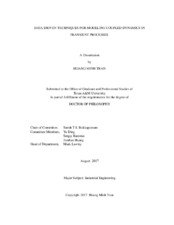| dc.description.abstract | We study the problem of modeling coupled dynamics in transient processes that happen in a network. The problem is considered at two levels. At the node level, the coupling between underlying sub-processes of a node in a network is considered. At the network level, the direct influence among the nodes is considered. After the model is constructed, we develop a network-based approach for change detection in high dimension transient processes. The overall contribution of our work is a more accurate model to describe the underlying transient dynamics either for each individual node or for the whole network and a new statistic for change detection in multi-dimensional time series. Specifically, at the node level, we developed a model to represent the coupled dynamics between the two processes. We provide closed form formulas on the conditions for the existence of periodic trajectory and the stability of solutions. Numerical studies suggest that our model can capture the nonlinear characteristics of empirical data while reducing computation time by about 25% on average, compared to a benchmark modeling approach. In the last two problems, we provide a closed form formula for the bound in the sparse regression formulation, which helps to reduce the effort of trial and error to find an appropriate bound. Compared to other benchmark methods in inferring network structure from time series, our method reduces inference error by up to 5 orders of magnitudes and maintain better sparsity. We also develop a new method to infer dynamic network structure from a single time series. This method is the basis for introducing a new spectral graph statistic for change detection. This statistic can detect changes in simulation scenario with modified area under curve (mAUC) of 0.96. When applying to the problem of detecting seizure from EEG signal, our statistic can capture the physiology of the process while maintaining a detection rate of 40% by itself. Therefore, it can serve as an effective feature to detect change and can be added to the current set of features for detecting seizures from EEG signal. | en |


